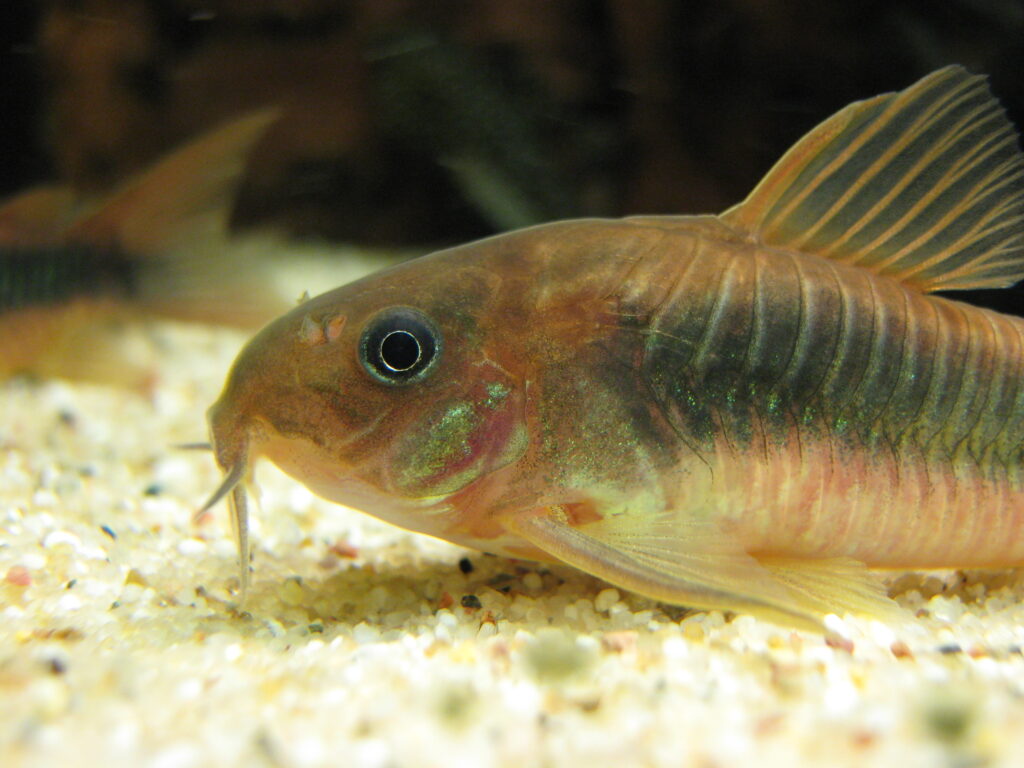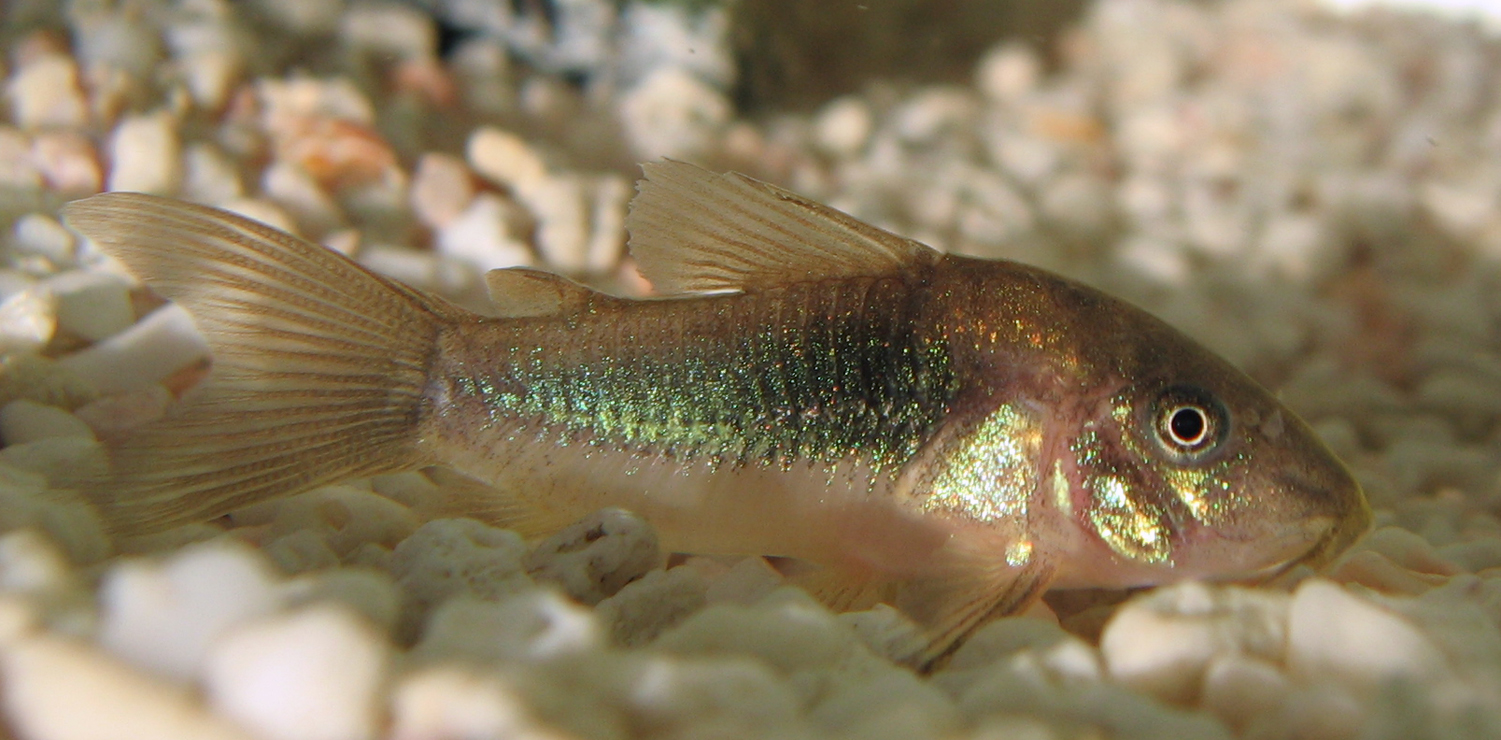Bronze Corydoras
Bronze Corydoras, corydoras aeneus, are amongst the best-loved bottom dwellers that you can introduce to your community aquarium.
Since the mid-1800s, they’ve been a staple in the tropical fish industry and are favored by fishkeepers of various experience levels.
- Experience Level: Beginner
- Hardiness: Hardy
- Minimum Tank Size: 10 gal (40 L)
- Maximum Size: 3 inches (8 cm)
- Temperament: Peaceful
- Temperature: 72 – 84° F (22 – 29° C)
- pH Range: 5.8 – 7.8
- Water Hardness: 2 – 25 dGH
- Diet: Omnivore
Table of Contents
Introduction
Size and Appearance
Care Guide
Tank Mates
Diet and Feeding
Breeding
From the eastern slopes of the Andes, stretching from Columbia and Trinidad to the Rio De La Plata river basin, originates the Bronze Corydoras, a small South American catfish species.
Their preferred habitats are warm and shallow waters, with a slow current and soft bottoms. They’re often found in heavily silty or discolored water and can gulp air from the surface to supplement their gills.
Since the mid 1800s, they have been harvested and successfully bred in captivity globally. Mature specimens measure between 2 to 3 inches in length. Female Corydoras tend to be more prominent, having a more robust body. Notably, the lifespan of the Bronze corydoras can span over a decade, making for a lasting relationship with your aquatic pet.
Size and Appearance
Bronze corydoras are armored with a series of bony plates covering their bodies. Primarily found in catfish, they have a dorsal fin spined with a venomous sting. Fishkeepers should be extra careful when handling their fish. The common practice is to flip the corydoras onto its back and seclude the dorsal fin between fingers to avoid any sting.
Their body pigmentation ranges from bronze to olive, moving down to a lighter belly. A distinct, darker stripe that outshines their body color marks the corydora’s side. The stripe might be bronze, olive, dark purple or in-between shades.
Both sexes have a pair of barbels on each side of the mouth to aid in securing food in the dark or cloudy water.
The ever-turning wheel of commercial breeding has given rise to several color variations, the most unique being the albino corydoras. While maintaining the same armored look, their colors range from pink to white and cream.
Making a purchase from a trustworthy breeder is important as some variations could be dyed fish, sometimes through injecting color into them.
Although they may not be the most visually havenly species, Bronze corydoras have plentiful personalities, being very social and diligent. They thrive best in groups of 5 or more, sifting along the base of the aquarium in search of food.
They dig around the substrate so persistently that it results in small clouds of sediment stirred up. Their exploration may lead to confrontations with bottom-dwelling egg laying species.
Care Guide
- Minimum Tank Size: 10 gal (40 L)
- pH Range: 5.8 – 7.8
- Water Hardness: 2 – 25 dGH
- Temperature: 72 – 84° F (22 – 29° C)
- Lighting: Moderate, diffused lighting
- Substrate: Fine sand/gravel
- Brackish: No
- Water Flow: Weak/Low
- Tank Region: Bottom
Corydoras aeneus aren’t fastidious about water composition and can easily adapt to the water quality and temperature necessary for a South American or Amazon basin community tank. Args that they flourish in are a temperature range of 72°F to 84°F (22–29°C), a PH of 5.8 to 7.8, and a soft to medium hardness with a range of 2-25.
Small groups of Bronze corydoras can comfortably live in a 10 gallon aquarium. They feel more content in groups of at least five when housed in larger aquariums.
You can select tank lighting and filtration based on the needs of the majority of shares, with Bronze corydoras being highly adaptable to current flow and day/night lighting.
Their natural habitats usually consist of soft sand or mud bottom covered by decomposing plant matter. You can duplicate this environment for your corydoras using aquarium sand or soft gravel.
Bronze corydoras will welcome you incorporating plants, rocks, and driftwood to satisfy the community needs. The structure provides them hiding spots and paths for their endless journey to finding food.
Tank Mates
Bronze corydoras find almost every peaceful fish and invertebrate species compatible. Here are some species best suited as tankmates for Bronze corydoras in Amazon community aquariums:
- Guppy: Various guppy species make great tankmates for most Amazon community tanks. They are peaceful, appropriately sized, and compatible with any thing that doesn’t threaten to eat them. The more ornamental varieties contribute to the aquarium decor as long as no other tank mates indulge in fin nipping.
- Other Corydoras: Like plecos, corydoras constitute bottom-feeding catfish commonly introduced into tropical freshwater aquariums. These peaceful omnivores grow to a size of 4 inches.
- Cardinal Tetra: They are great companions for numerous gentle species. Introducing a small group of Cardinal Tetra adds charm to your aquarium without significantly affecting the bioload. Reliable choice in groups of 10.
- Neon Tetra: Another great companion for apple snails. They, too, are added in groups of 10 per 20-gallon tank and make for an ever-moving, shimmering display.
- Green Neon Tetra: If you desire a brilliantly colored aquarium, the Green Neon Tetra should be on your list. Very similar to the Neon Tetra, the green Neon Tetra has an attractive streak of neon green along its side.
Feeding Guide
- Diet: Omnivore
- Frequency: Several small feedings per day
- Pellet Foods: Yes
- Flake Foods: Yes
- Live Foods: Yes
- Meat Foods: Yes
- Vegetable Foods: Yes
Bronze corydoras are easy to feed among community species. Besides foraging on the bottom, they consume flaked or pelleted foods, live foods, and frozen foods. Their primary food requirement is that it be dense enough to reach the bottom.
Common feeding options include:
- Algae tablets or wafers
- Cucumber
- Carrots (sliced or cut)
- Green beans
- Omnivore flakes
- Peas
- Lettuces like Romaine and others
- Spinach
- Squashes e.g., zucchini
If using vegetables, blanch them in hot water to soften their texture. They can be blanched in bulk and frozen in feeding-sized batches for easy management.
Breeding
Bronze corydoras spawn in association with the rainy season and subsequent changes in water quality. They spawn spontaneously, but a water change of over 30% can induce this behavior.
If you plan on raising fry, it’s best to separate your breeding pairs to prevent tank mates from eating them. Also, having double the males for each female can guarantee sufficient sperm for well-fertilized eggs.
You may see your male corydoras squabble, which happens only when they simultaneously court a female.
Watch out for your corydoras’ behavior. Courting is indicated by the male posing sideways to the female. This way, the female can easily swallow the male’s sperm. She may repeat this process with more than one male.
Female bronze corydoras lay their eggs in small batches of 10 to 20. The eggs are fertilized as they’re released. Over a few hours, she can lay upto 200 eggs, mostly among water plants and vegetation.
Once the eggs are laid, you should return the adult bronze corydoras to the community tank as they show no parental reservation towards their young. Keep an eye on their procreation cycle as they can spawn again as frequently as every two to three weeks.
Observe the color of their eggs. Freshly laid eggs are light and transparent. It takes about three days for them to hatch, during which you’ll see the eggs darken till they turn a deep brown.
The newly hatched stay at the bottom feeding on algae and decomposing matter. After a few weeks, they grow large enough to be introduced in a community aquarium.



